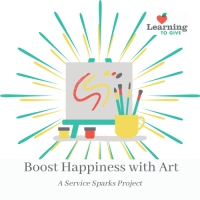Ignite meaningful action that lights up the world through "Service Sparks" youth projects! Lift others’ spirits with kind messages and art in windows and on sidewalks. Back up your kind messages with a little investigation of what makes people happy.
This lesson explains what the Census is and why it is important for everyone. Every ten years, we count everyone who is living in the U.S., from babies to the oldest people. This gives our government a clear idea of who lives where and regions where we have growth or decrease in population. If we know who lives where, we can make sure to provide services, such as education, health care, public services, and food/housing in the needed places.
- Read more about What Is the Census and Why Is it Important?
- Log in or register to post comments
Students learn how and challenge others to reduce waste based on observing habits in the lunchroom or in the classroom trash can.
Adapt this one-period lesson plan for your grade level and follow it with a simple and powerful service project for Earth Day. The reflection brings learning and service impact together.
- Read more about Lunchroom Recycling Plan (primary)
- Log in or register to post comments
Learners walk around their neighborhood parks observing plants, use of space, and ways to make the shared space better. They problem-solve about things they can do and then interview and survey others to get ideas and permission to take action.
- Read more about Make an Outdoor Space Better for All
- Log in or register to post comments
Learners make a talent chain for the group. This is a representation of the many strengths and talents each learner brings, making the whole group strong. A children's book sparks a joyful idea for community members to connect over art, and the learners establish a relationship with people at a retirement home or preschool.
- Read more about Sharing in Community
- Log in or register to post comments
Students gain empathy and use language to describe the mixed feelings that come with being new to a community. They watch and discuss video clips and compare character traits. Then they read a book and discuss how the book guides them to welcome new students to the classroom as the year progresses. As a service, they create coupon books for new students to use to get to know classroom routines and people.
- Read more about Creating a Welcoming Classroom All Year
- Log in or register to post comments
At the beginning of the year we get to create our classroom community. We get to decide how we will learn and grow and play with each other for the rest of the year. This is a new beginning for all. As we start to decide what kind of classroom community we are going to be, we begin by thinking about the importance of the words we use with each other.
- Read more about Engaging in Critical Conversations
- Log in or register to post comments
Building a caring and inclusive classroom begins with an understanding of where students are at not just academically, but emotionally. Many students today have been exposed to experiences that affect their ability to regulate their emotions. By teaching children positive behavior and self-regulation, teachers can help improve outcomes for all students and build a caring community. This lesson will introduce students to mindful activities and the use of gratitude journals.
- Read more about Self-Regulation in the Classroom
- Log in or register to post comments
In this lesson, the students learn to use their voice to say something to make the world a better place. This is an opportunity to demonstrate and feel the impact of kindness, inclusion, and listening on a caring community. Students learn from a community helper about the needs they observe in the community. They make and donate a "calming box" so the tool may help youth calm themselves. Use this at the beginning of the year to set a tone and learn skills of effective language that are good for all.
- Read more about Words Bring Peace (elementary)
- Log in or register to post comments
Students organize and implement a school-based recycling plan based on a one-day lunchroom waste audit.
Adapt this one-period lesson plan for your grade level and follow it with a simple and powerful service project for Earth Day. The reflection brings learning and service impact together.
- Read more about Lunchroom Recycling Plan (elementary)
- Log in or register to post comments
